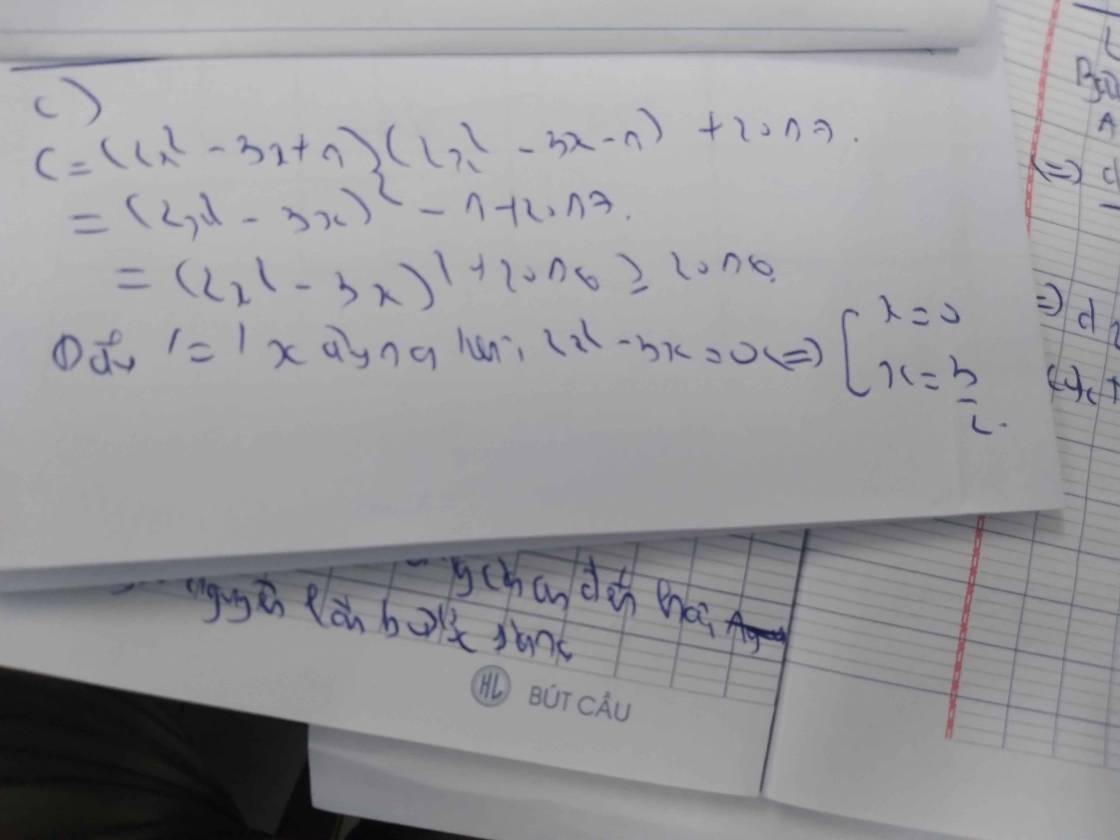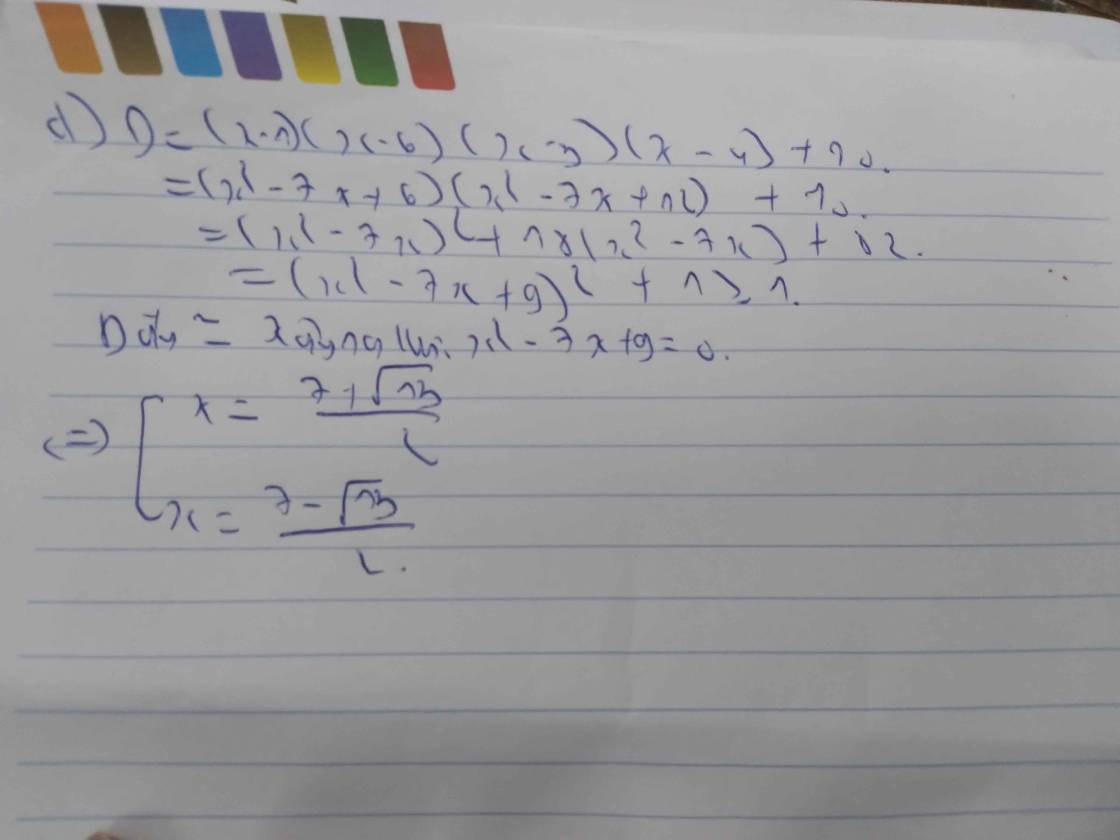\(\left(x^2-4x^2\right)-\left(x-2\right)^2+10.\)
Hãy nhập câu hỏi của bạn vào đây, nếu là tài khoản VIP, bạn sẽ được ưu tiên trả lời.


\(M=\left(7-2x\right)\left(4x^2+14x+49\right)-\left(64-8x^3\right)\)
\(M=\left(7-2x\right)\left[\left(2x\right)^2+2x\cdot7+7^2\right]-\left(64-8x^3\right)\)
\(M=\left[7^3-\left(2x\right)^3\right]-\left(64-8x^3\right)\)
\(M=343-8x^3-64+8x^3\)
\(M=279\)
Vậy M có giá trị 279 với mọi x
\(P=\left(2x-1\right)\left(4x^2-2x+1\right)-\left(1-2x\right)\left(1+2x+4x^2\right)\)
\(P=8x^3-4x^2+2x-4x^2+2x-1-1+8x^3\)
\(P=16x^3-8x^2+4x-2\)
Thay \(x=10\) vào P ta có:
\(P=16\cdot10^3-8\cdot10^2+4\cdot10-2=15238\)
Vậy P có giá trị 15238 tại x=10
a: M=343-8x^3-64+8x^3=279
b: P=8x^3-4x^2+2x-4x^2+2x-1-1+8x^3
=16x^3-8x^2+4x-2
=16*10^3-8*10^2+4*10-2=15238

Bạn xem lại đề nhé.
a) \(A=x^2+5y^2+2xy-4x-8y+2015\)
\(A=x^2-4x+4-2y\left(x-2\right)+y^2+2011+4y^2\)
\(A=\left(x-2\right)^2-2y\left(x-2\right)+y^2+2011+4y^2\)
\(A=\left(x-2-y\right)^2+4y^2+2011\)
Vì \(\left(x-y-2\right)^2\ge0;4y^2\ge0\)
\(\Rightarrow A_{min}=2011\)
Dấu bằng xảy ra : \(\Leftrightarrow\left\{{}\begin{matrix}x-y-2=0\\4y^2=0\end{matrix}\right.\Leftrightarrow}\left\{{}\begin{matrix}x=2\\y=0\end{matrix}\right.\)

1: Ta có: \(4x^2-36=0\)
\(\Leftrightarrow\left(x-3\right)\left(x+3\right)=0\)
\(\Leftrightarrow\left[{}\begin{matrix}x=3\\x=-3\end{matrix}\right.\)
2: Ta có: \(\left(x-1\right)^2+x\left(4-x\right)=11\)
\(\Leftrightarrow x^2-2x+1+4x-x^2=11\)
\(\Leftrightarrow2x=10\)
hay x=5

\(1,\\ b,\Leftrightarrow\left(x^2+4x+4\right)+\left(y-1\right)^2=25\\ \Leftrightarrow\left(x+2\right)^2+\left(y-1\right)^2=25\)
Vậy pt vô nghiệm do 25 ko phải tổng 2 số chính phương
\(2,\\ a,\Leftrightarrow x^2-\left(y^2-6y+9\right)=47\\ \Leftrightarrow x^2-\left(y-3\right)^2=47\)
Mà 47 ko phải hiệu 2 số chính phương nên pt vô nghiệm
\(b,\Leftrightarrow\left(x-2\right)^2+\left(3y-1\right)^2=16\)
Mà 16 ko phải tổng 2 số chính phương nên pt vô nghiệm
2b,
Vì 16 ko đồng dư với 1 (mod 4) nên 16 ko phải là tổng 2 scp
Định lý Fermat về tổng của hai số chính phương – Wikipedia tiếng Việt
vô đây đọc nhé

\(1\)) \(70:\frac{4x+720}{x}=\frac{1}{2}\)
\(\Leftrightarrow\frac{4x+720}{x}=70:\frac{1}{2}\)
\(\Leftrightarrow\frac{4x+720}{x}=140\)
\(\Leftrightarrow\left(4x+720\right):x=140\)
\(\Leftrightarrow4x+720=140.x\)
\(\Leftrightarrow4x-140x=-720\)
\(\Leftrightarrow x.\left(-136\right)=-720\)
\(\Leftrightarrow x=-720:\left(-136\right)\)
\(\Leftrightarrow x=\frac{90}{17}\)
\(2\)) Mình đang nghĩ

a) Ta có: \(\left(x-1\right)^2+x^2-1=\left(x+1\right)\left(x+3\right)\)
\(\Leftrightarrow\left(x-1\right)^2+\left(x-1\right)\left(x+1\right)=\left(x+1\right)\left(x+3\right)\)
\(\Leftrightarrow\left(x-1\right)\left(x-1+x+1\right)=\left(x+1\right)\left(x+3\right)\)
\(\Leftrightarrow\left(x-1\right)\cdot2x-\left(x+1\right)\left(x+3\right)=0\)
\(\Leftrightarrow2x^2-2x-\left(x^2+4x+3\right)=0\)
\(\Leftrightarrow2x^2-2x-x^2-4x-3=0\)
\(\Leftrightarrow x^2-6x-3=0\)
\(\Leftrightarrow x^2-6x+9-12=0\)
\(\Leftrightarrow\left(x-3\right)^2-12=0\)
\(\Leftrightarrow\left(x-3\right)^2=12\)
\(\Leftrightarrow\left[{}\begin{matrix}x-3=\sqrt{12}\\x-3=-\sqrt{12}\end{matrix}\right.\Leftrightarrow\left[{}\begin{matrix}x=\sqrt{12}+3=3+2\sqrt{3}\\x=-\sqrt{12}+3=3-2\sqrt{3}\end{matrix}\right.\)
Vậy: \(x=3\pm2\sqrt{3}\)


\(\left(x^2-4x^2\right)-\left(x-2\right)^2+10\)
\(=x^2-4x^2-x^2+4x-4+10\)
\(=-4x^2+4x+6\)
\(\left(x^2-4x^2\right)-\left(x-2\right)^2+10\)
\(=x^2-4x^2-x^2+4x-4+10\)
\(=-4x^2+4x+6\)
~ học tốt nhé #Châu FAKKER